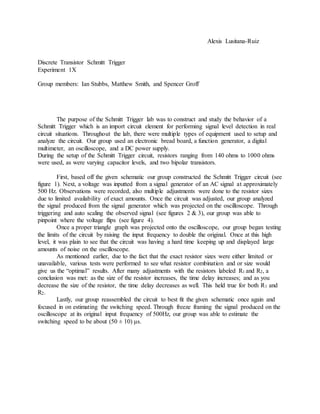digitallab.docx
•Télécharger en tant que DOCX, PDF•
1 j'aime•59 vues
Signaler
Partager
Signaler
Partager

Recommandé
Recommandé
Contenu connexe
Tendances
Tendances (20)
Similaire à digitallab.docx
Similaire à digitallab.docx (20)
Tennessee State University College of Engineering, Tec.docx

Tennessee State University College of Engineering, Tec.docx
Investigation of Anomalous Thrust and Proposal for Future Experimentation

Investigation of Anomalous Thrust and Proposal for Future Experimentation
Assessment of cardiac contractility using langendorff apparatus connected to ...

Assessment of cardiac contractility using langendorff apparatus connected to ...
paper on Wireless power transmission using magnetic resonance

paper on Wireless power transmission using magnetic resonance
Am Radio Receiver And Amplifier Experiment And Am Transmission Demonstration

Am Radio Receiver And Amplifier Experiment And Am Transmission Demonstration
digitallab.docx
- 1. Alexis Lusitana-Ruiz Discrete Transistor Schmitt Trigger Experiment 1X Group members: Ian Stubbs, Matthew Smith, and Spencer Groff The purpose of the Schmitt Trigger lab was to construct and study the behavior of a Schmitt Trigger which is an import circuit element for performing signal level detection in real circuit situations. Throughout the lab, there were multiple types of equipment used to setup and analyze the circuit. Our group used an electronic bread board, a function generator, a digital multimeter, an oscilloscope, and a DC power supply. During the setup of the Schmitt Trigger circuit, resistors ranging from 140 ohms to 1000 ohms were used, as were varying capacitor levels, and two bipolar transistors. First, based off the given schematic our group constructed the Schmitt Trigger circuit (see figure 1). Next, a voltage was inputted from a signal generator of an AC signal at approximately 500 Hz. Observations were recorded, also multiple adjustments were done to the resistor sizes due to limited availability of exact amounts. Once the circuit was adjusted, our group analyzed the signal produced from the signal generator which was projected on the oscilloscope. Through triggering and auto scaling the observed signal (see figures 2 & 3), our group was able to pinpoint where the voltage flips (see figure 4). Once a proper triangle graph was projected onto the oscilloscope, our group began testing the limits of the circuit by raising the input frequency to double the original. Once at this high level, it was plain to see that the circuit was having a hard time keeping up and displayed large amounts of noise on the oscilloscope. As mentioned earlier, due to the fact that the exact resistor sizes were either limited or unavailable, various tests were performed to see what resistor combination and or size would give us the “optimal” results. After many adjustments with the resistors labeled R1 and R2, a conclusion was met: as the size of the resistor increases, the time delay increases; and as you decrease the size of the resistor, the time delay decreases as well. This held true for both R1 and R2. Lastly, our group reassembled the circuit to best fit the given schematic once again and focused in on estimating the switching speed. Through freeze framing the signal produced on the oscilloscope at its original input frequency of 500Hz, our group was able to estimate the switching speed to be about (50 ± 10) μs.
- 2. Figure 1: Setup of circuit Figure 2: 500 Hz signal
- 3. Figure 3: 500 Hz Figure 4: propagation delay